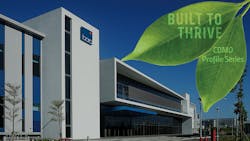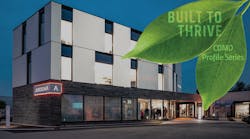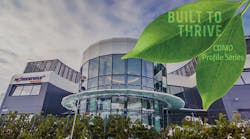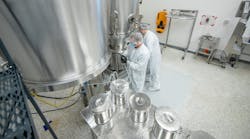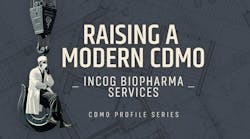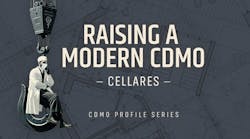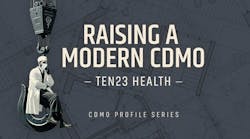For close to two decades, the Taipei 101 skyscraper has been a pinnacle on the city’s horizon.
The tallest building in Taiwan, the engineering marvel was designed to symbolize the nation’s rising prosperity on the world stage by carefully combining traditional elements with emerging technologies.
But if you’re going to build a 1,667-foot-high building in an earthquake and tropical storm zone, you have to construct it with a plan. Suspended beneath the Taipei 101’s observatory deck is a giant steel pendulum that gently sways back and forth to counter any vibration caused by outside forces. Building a CDMO powerhouse that can flex and bend with a changing industry is much the same — it requires an ambitious yet well thought-out strategy.
For Bora Pharmaceuticals, it started with a single acquisition — but it didn’t stop there.
In 2013, Bora bought its initial manufacturing site in Tainan, Taiwan from Eisai Pharmaceuticals. The divested plant, though aging, was PIC/S certified and had plentiful expansion possibilities. That purchase would be the first in the string of many that launched what is now Taiwan’s largest pharmaceutical group by volume.
Bora was originally established as an independent manufacturing entity of the family-owned Taiwanese company, Hoan Pharmaceuticals. Hoan had begun expanding its business from in-licensing and distributing to include R&D and manufacturing with a focus on new formulations and indications for pre-existing drugs, ultimately deciding in 2007 to launch Bora Pharmaceuticals.
At the helm of Bora was charismatic Bobby Sheng, who, together with his sister, had inherited Hoan from his father back in 1992. Sheng, serving as Bora’s chief executive officer and chairman, recognized the growing demand for high-quality, customer-centric CDMOs in Asia. But he also had big ambitions.
“Bora’s goal has always been to become a world-leading CDMO. To do so, we need to have strategically located development and manufacturing sites all over the world,” says Sheng.
The company’s growth strategy has relied heavily on acquisitions — six in the past eight years to be precise — but for Sheng, snatching up infrastructure is only the beginning of what it takes to build a pharmaceutical pillar.
“Bora’s pace of growth can be attributed to the acquisitions we’ve made. However, we view our acquisitions as an accelerator of our business plan, not the foundation of it,” says Sheng.
Now operating six state-of-the-art CGMP manufacturing facilities — five in Taiwan and one in Canada — Bora currently produces 12% of all drug products exported from Taiwan. The CDMO’s aggressive and pointed business plan has enabled it to simultaneously build global trust in its services as well as in the Taiwanese pharma market at large.
Hitting high notes
For Bora, 2022 was a year of milestones.
Back in May, the company announced the establishment of Bora Biologics, a CDMO platform specifically for biologic drugs.
While Bora is no stranger to biologic drugs — according to Sheng, it is one of the few sites in Asia that can claim involvement in a dozen biosimilar projects — the CDMO’s core competency has been in oral solid dose, liquid and semi-solid prescription and OTC products.
As part of its official foray into complex biologics, Bora bought Eden Biologics’ contract manufacturing facility in Hsinchu Biomedical Science Park in Taiwan. With the acquisition of this facility, Bora gained technologies related to the development of cell lines for protein drug production, upstream and downstream processes, and quality control and inspections.
The deal was designed to help Bora rapidly build a presence in the fast-growing biological macromolecules market.
But Bora wasn’t done racking up milestones quite yet.
In September 2022, Bora claimed its title as the largest pharma group in Taiwan after completing what the company called a ‘landmark acquisition’ of Taiwan-based TWi Pharmaceuticals and its subsidiaries — including its U.S. operations. TWi — whose U.S. business has remained a separate entity — focuses on niche generics, specifically those with strong opportunities in the American market.
In addition to two manufacturing facilities in Taiwan, the purchase gives Bora access to TWi’s U.S. sales channels.
A strong foundation
While they can quicken the pace, acquisitions alone can’t build a thriving company.
According to Sheng, ensuring that Bora’s acquisition strategy is closely aligned with the company’s values can be challenging. Above all, it requires well-defined processes for identifying the deals that will most benefit both the company and its customers.
“Acquisitions come with great potential value, but with every acquisition, there must be an agreement about the elements that matter the most,” says Sheng.
And what matters to Bora is its relationships, both internal and external. The CDMO, which currently employs over 1,250 people, places great significance on client partnerships and company culture.
“Bora is moving at the speed of light with its acquisition strategy and all teams must be onboard to ensure a smooth and successful transition of ownership,” says Sheng. “A strong company culture with engaged employees will contribute to our customer’s success and is a victory for both Bora and the customer."
Still reaching for the sky
Despite a busy few years, Bora is not done acquiring. But more importantly, the company is not done improving on its existing assets. “Bora continues to look at site acquisitions that fit with the service offerings our clients are looking for, as well as expanding our capabilities with technology at our current facilities,” says Sheng.
The company recently committed to a $10 million expansion of its oral solid dose capabilities across facilities in Zhunan, Taiwan and Mississauga, Ontario.
Coinciding with the expansion, the company reestablished its pilot plant in the Mississauga facility, which contains 26 discreet rooms to enable multiple clinical programs to be run simultaneously. The equipment in the pilot plant is scalable to commercial equipment and Bora has acquired various smaller assets to enhance the area into a fully functioning CGMP and non-CGMP area.
Bora’s compliance track record in its facilities has been meticulous — five consecutive FDA audits over the last eight years, with zero Form 483 observations and no critical findings from other regulatory agency inspections.
And it’s not just Bora’s facilities that are scoring good marks. In 2020, Sheng was named CEO of the Year at the CPHI Pharma Awards. When he was awarded this accolade, judges called Bora Pharmaceuticals, under his leadership, a “trailblazer” in Taiwan and applauded the company for elevating the pharma market overall.
Bora Pharma now delivers to more than 100 markets around the world including the U.S./Canada, EU, Southeast Asia, Middle East, and South and Central Americas.
With its origins as a family-run company situated in a small island nation, Bora could have easily been overshadowed by long-standing Asian CDMO behemoths — but instead built a company capable of soaring above.
